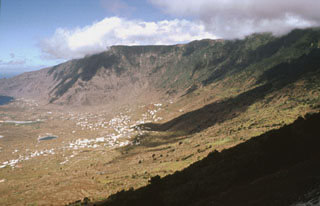Report on Hierro (Spain) — 23 November-29 November 2011
Smithsonian Institution / US Geological Survey
Weekly Volcanic Activity Report, 23 November-29 November 2011
Managing Editor: Sally Sennert.
Please cite this report as:
Global Volcanism Program, 2011. Report on Hierro (Spain) (Sennert, S, ed.). Weekly Volcanic Activity Report, 23 November-29 November 2011. Smithsonian Institution and US Geological Survey.
Hierro
Spain
27.73°N, 18.03°W; summit elev. 1500 m
All times are local (unless otherwise noted)
Instituto Geográfico Nacional (IGN) reported that during 23-29 November the submarine eruption continued S of El Hierro Island. During this period, the mean amplitude of the tremor showed a slight increase. On 26 November large steaming fragments of lava appeared intermittently floating over the emission center. On 27 November, the emissions were more intense and a few hundred fragments could be observed floating simultaneously, with mean dimensions between 0.5 and 2 m. Some samples of the fragments were collected from a ship near the emission area.
During the period, 121 seismic events were located, most of them offshore to the N of the island at depths of 15-23 km and a maximum magnitude of 3.3. Seven of these events were felt by residents at a maximum intensity value of III using EMS-98 (European Macroseismic Scale). GPS data analyses trended towards stability in the horizontal components, while in the vertical component most of the stations showed subsidence while stations in the NE of the island also trended towards stability.
Geological Summary. The triangular island of Hierro is the SW-most and least studied of the Canary Islands. The massive shield volcano is truncated by a large NW-facing escarpment formed as a result of gravitational collapse of El Golfo volcano about 130,000 years ago. The steep-sided scarp towers above a low lava platform bordering 12-km-wide El Golfo Bay, and three other large submarine landslide deposits occur to the SW and SE. Three prominent rifts oriented NW, NE, and S form prominent topographic ridges. The subaerial portion of the volcano consists of flat-lying Quaternary basaltic and trachybasaltic lava flows and tuffs capped by numerous young cinder cones and lava flows. Holocene cones and flows are found both on the outer flanks and in the El Golfo depression. Hierro contains the greatest concentration of young vents in the Canary Islands. Uncertainty surrounds the report of an eruption in 1793. A submarine eruption took place about 2 km SSW off the southern point of the island during 2011-12.

